This bespoke insider travel guide to Maui, Hawaii features everything you need to know about the best things to do, see, and explore on the island.
As we previously wrote in our Insider’s Guide to Maui’s Best Restaurants, Maui is a culturally dynamic place. Of all the Hawaiian islands, it offers perhaps the most variety in terms of climate, vegetation, neighborhoods, and commercial intrigue.
This, in part, stems from its location within the center of the Hawaiian archipelago, as well as its unique geographic circumstances. Maui is called “The Valley Isle” because its lush valleys and arid plains are sandwiched between two hulking topographical features: Haleakala Volcano to the East, and the West Maui Mountains to the West.
The resulting island is full of diverse ecosystems, including hidden jungles, high-altitude farmscapes, golden sand beaches, black lava outcroppings, alpine forests, and sea-level stretches of what can sometimes look like a desert landscape.
Cultural diversity, meanwhile, seems to mirror the landscape diversity in Maui. The Old Sugar Mill of Koloa (and the sugar industry writ large) historically brought in over 337,000 workers from China, Japan, Korea, Portugal, and the Philippines, beginning as early as the 1840s.
Though only the stone chimney and foundation of the mill remain (–it’s now a National Historic Landmark,) the cultural diversity that its influx of immigration brought to Maui persists to this day.
Maui, like all of Hawaii, is a melting pot– and this is perhaps best reflected in the fusion cuisine that dominates the island’s restaurant scene, as well as the inclusive, welcoming nature of the people who live here.
Ultimately, this Maui travel guide explores what makes each region of Maui unique and special– from dining and watersports to natural wonders, relaxing spas, unique local farm tours, Polynesian history and culture, quirky hidden gems, and more. It’s optimized to showcase the coolest, most unique experiences Maui has to offer– and the things that leave you with an undeniable sense of place.
You might see Woody Harrelson at a sushi bar in Ha’iku, or stumble upon Oprah’s mountaintop ranch in Upcountry. The Beatles’ George Harrison even had a home in Hana long before it was considered “the last true Hawaii” and one of the most majestic tourist destinations on the island.
There’s a reason, moreover, why the well-heeled have been flocking to Maui for generations. The best parts of the island have a certain divine magic about them. (And this makes sense, as the word Maui literally means “demigod” in Hawaiian.)
Below, we spotlight the best, coolest things to do, see, explore, eat, and discover in Maui, Hawaii. We also include insider info on where to stay, beautiful places to relax, unique cultural opportunities you might not hear about in other Maui travel guides, and some cool hidden gems you might otherwise miss.
There’s a lot to take in and we pride ourselves on being thorough, but the info below is indispensable. Bookmark this guide for easy reference later. It’s the only Maui travel guide you’ll ever need.
Aloha and E Komo Mai ! 🙂
***
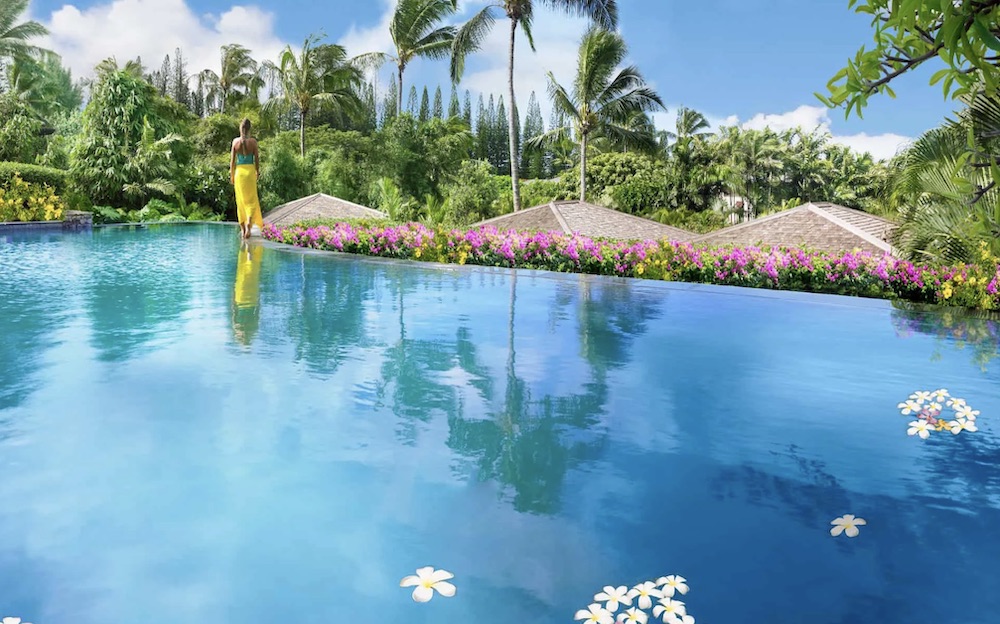
Where To Stay in Maui
A basic breakdown of Maui’s most iconic neighborhoods– and the benefits of staying in each place.
- Lahaina – Touristy, for sure, but this oceanfront downtown village is a convenient go-to for families who want to be able to walk everywhere. There are lots of restaurants on Front Street (Italian, seafood, sushi, you name it) as well as trinket shops, art galleries, bars, and the largest banyan tree in Hawaii! Because it’s nestled between the coast and the West Maui Mountains, it also has nice mountain views.
- Upcountry – A quiet, wilderness lovers paradise on the slopes of Haleakala with cooler temps, Eucalyptus forests, and gorgeous views across the entire island. Oprah’s Maui ranch is located here.
- Wailea – Ritzy and somewhat bougie, with upscale resorts, restaurants, and beautifully manicured landscapes. This is also the location of the Four Seasons Resort Maui at Wailea, where the first season of HBO’s award-winning series, The White Lotus, was filmed.
- Pa’ia – Beatnik surfer town vibes close to the Road to Hana and Ho’okipa windsurfing beach. Great, cheap dining options and funky local art galleries and shops abound. A real local’s preferred hang-out spot.
- Hana – Lush, rugged jungle village ideal for nature lovers, minimalist, and those who want to “get away from it all”. There aren’t many restaurants out this way– save for a few roadside fruit stands, coffee shop cafes, barbecue pits, and ice cream kiosks. They don’t even have street lights, so it gets quite dark after sunset!
- Ha’iku – Luxuriously “hippy” neighborhood at the foot of Halekula where many celebrities and wellness gurus hang out. Lots of luxury private homes and estates for rent. Great sushi, yoga, meditation sanctuaries, and health retreats are located out this way.
- Kihei – Super affordable easygoing beachfront ‘hood with lots of convenient amenities like grocery stores and chain shops. This South Maui community is somewhat centrally located, so it’s a great place to snag an Air Bnb for an extended stay.
- Kula – A farm-and-ranch focused community on the western slopes of Haleakalā, spanning from Makawao to Ulupalakua. This is a great place for plant lovers to stay, with lavender farms and iconic plant nurseries within reach.
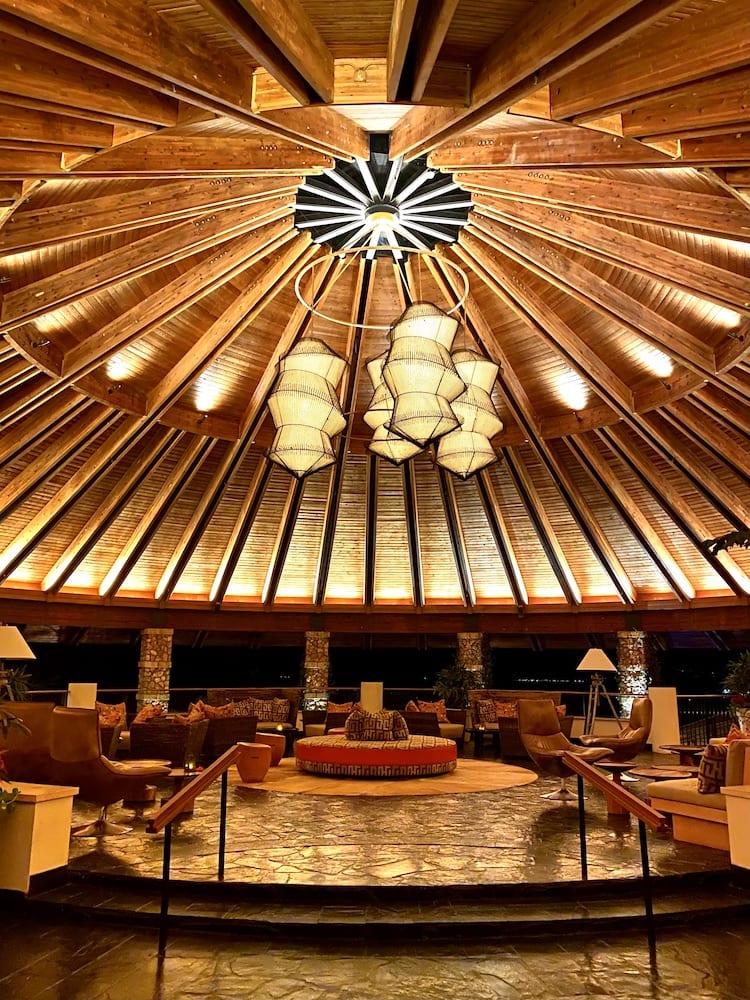
Notable Maui Hotels
Below are some of the best hotels in Maui for a unique and unforgettable stay.
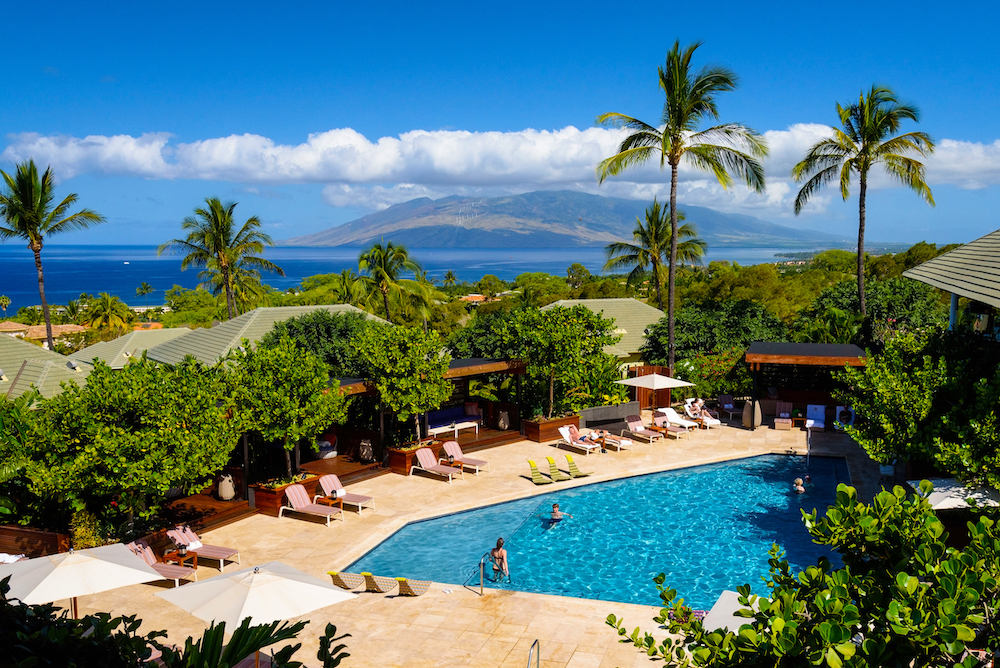
-
Hotel Wailea
In Maui, the Hotel Wailea is synonymous with world-class luxury. The Relais & Châteaux property is one of the top 100 hotels in the world and the No. 1 resort in Hawaii, ideal for honeymooners and those who want to stay in the lap of luxury.
This iconic Maui hotel has a fantastic on-site restaurant (more on that, below) and I love wandering through their tropical orchard to pick whatever exotic fruit is in season. (This could be citrus, avocados, etc.) It’s all lovely. And the decor, even in the common areas, is absolutely fabulous, featuring modern aesthetics, an abundance of earthen materials, local botanical motifs, and soothing natural sightlines.
For a fun, rejuvenating fitness experience, try an Aerial Yoga Class with hanging silks in their open-air wellness studio.
This adults-only resort also offers perfect access to Wailea Beach, with paddleboards, kayaks, and snorkel gear available for rent. (If, that is, you can drag yourself away from the cozy poolside cabanas.)
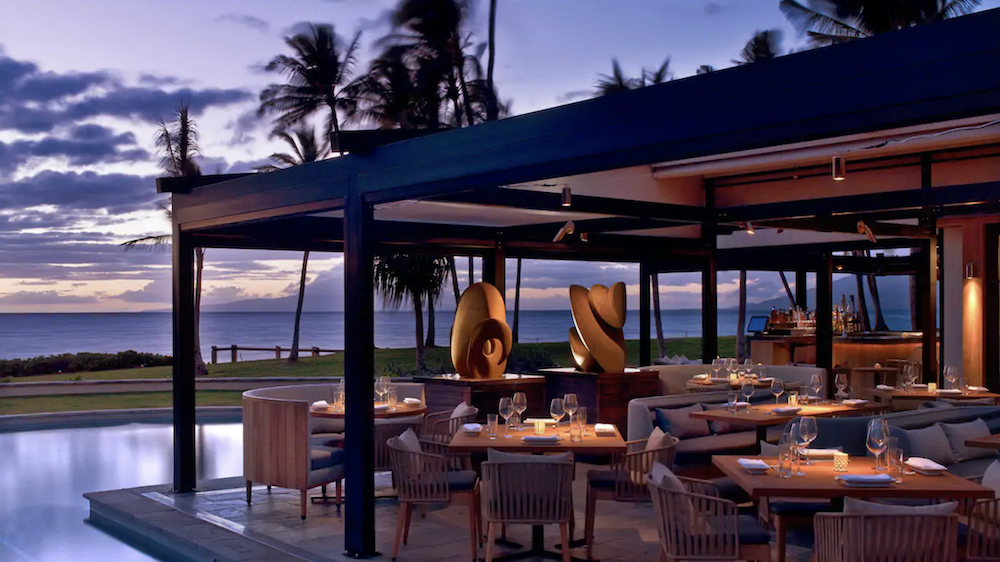
-
Andaz Maui
Their absolutely beautiful on-site spa is super famous and features a unique aromatherapy experience using elements that are native to Maui. Andaz Maui, moreover, is another classic Maui hotel in lovely Wailea– with a strong pan-Asian and Japanese influence, specifically in the spa and restaurant offerings.
Overall, it’s a great all-inclusive with super modern decor and a Morimoto Restaurant on-site. (<– Ideal for foodies and lovers of Asian cuisine!)
They are also a very eco-conscious hotel, with a solar-thermal energy system that boosts the property’s energy efficiency.
The fitness center, meanwhile, is top of the line and offers a wide variety of invigorating classes. Plus, there’s a great concierge service that can help you finesse any last-minute activities for your trip. (Dinner reservations, snorkeling, recommending local attractions, etc). They really know how to take care of you over here.
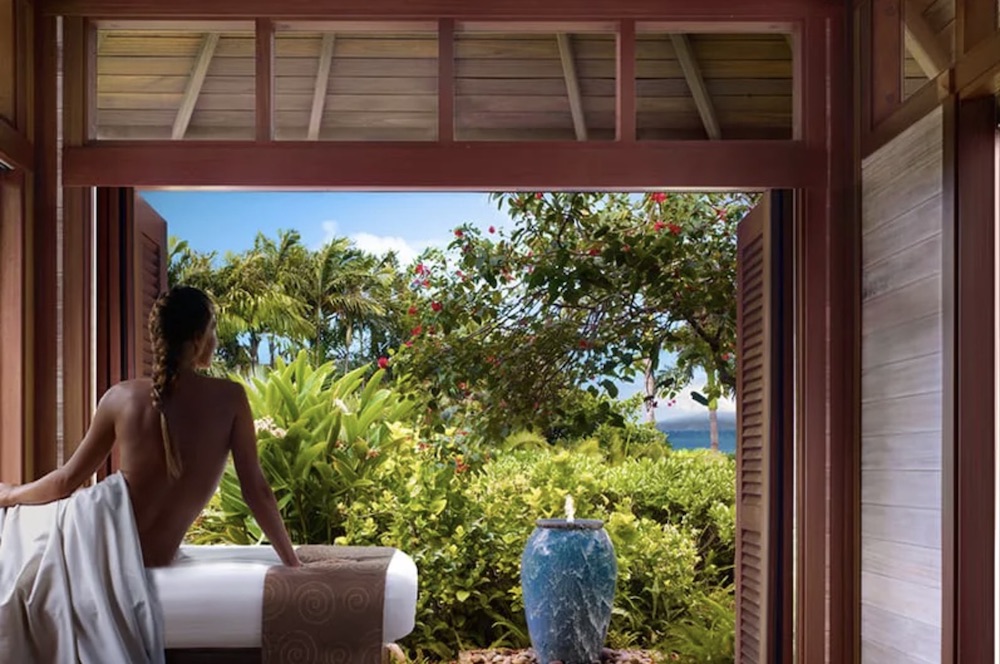
-
Montage Kapalua Bay
We love the cubic, futuristically designed spaces at Montage Kapalua Bay, which is one of the fancier and nicest hotels on Maui.
The angles and aesthetics here are on point. Even the lobby has stunning views and the award-winning on-site spa has a transfixing infinity pool. (Secure a shaded spot in one of their beautiful poolside cabanas for the quintessential lounging experience.)
Like all Montage properties, moreover, the Spa at Montage Kapalua Bay is absolutely incredible, capturing the spirit and allure of Hawaiian relaxation and rejuvenation through bespoke treatments and Maui-themed products inspired by the bounty of the island.
Dining-wise, you also have plenty of good options at the resort, from the upscale Cane & Canoe (where they serve authentic Hawaiian cuisine) to the more intimate Hideaway, where they serve local fare and island-inspired cocktails.
On-site Mahana Market, meanwhile, offers a bespoke collection of resort wear, bath & spa products, curated wines, coffee table books, and other unique local products from around the Hawaiian Islands.
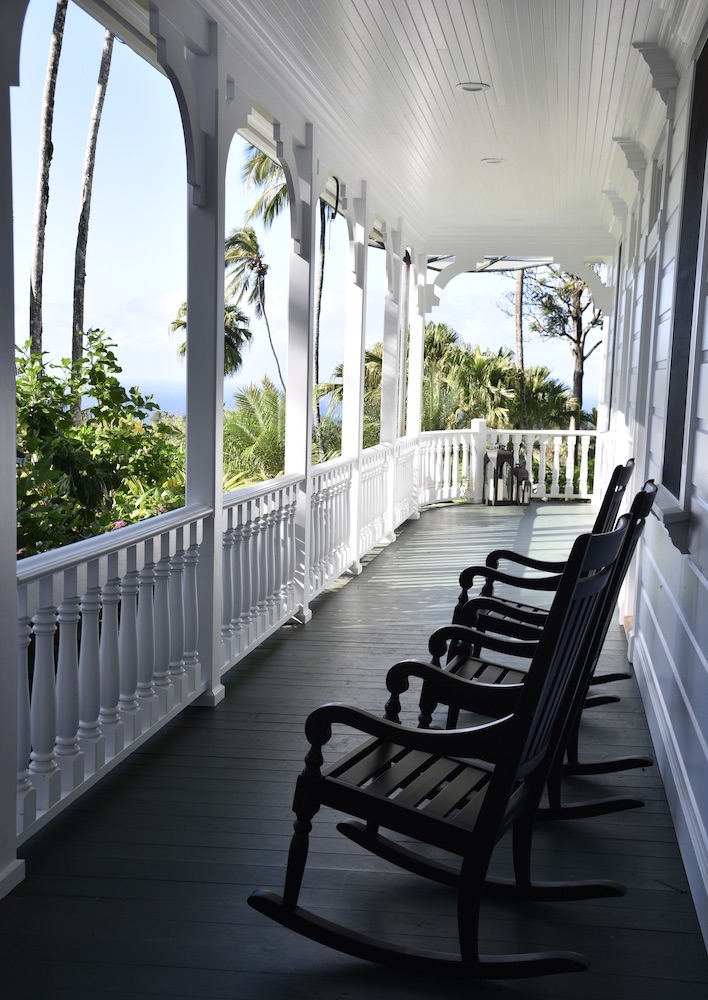
-
Haiku House Maui (Luxury Vacation Rental for Big Groups + Wedding Parties)
The Haiku House property in Haiku, Maui is absolutely stunning— easily the most beautiful rental home on the island. (At least that I’ve seen, and I’ve experienced the best of them.)
This luxury vacation rental is designed for large groups, as the property’s 9 gorgeously appointed rooms sit on 20 acres of lush private land on Maui’s North Shore.
In addition to the wonderful, spacious lanai and accommodating kitchen, living room, sunroom, and dining spaces, the house features a secluded in-ground swimming pool; an on-site orchard and vegetable garden wherein guests are welcome to harvest produce; a private yoga deck nestled under the shade of towering Moreton fig trees, and plenty of canopy-cloaked walking paths for peaceful morning strolls with a cup of coffee in hand
And with plenty of natural light and sun-streaked art adorning the walls, the house interiors reflect the botanical majesty of the surrounding landscape beautifully. Design lovers and nature lovers will both find something to covet.
Ultimately, this property is ideal for big groups and wedding parties, and it is very family-friendly.
If you’re looking for a private rental that feels like a hidden oasis on the island, Haiku House is easily the most compelling luxury rental home on Maui– and possibly all of Hawai’i, in general. It’s beyond serene!
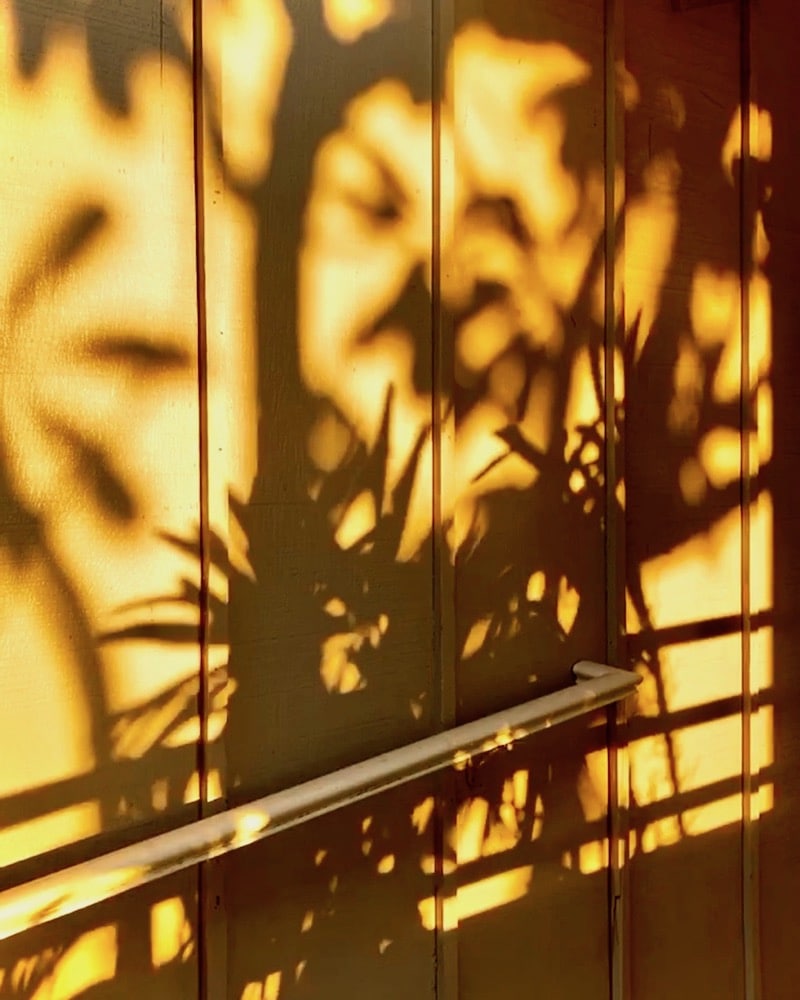
-
Air Bnb (Good Budget Option!)
There are lots of moderately-priced Air BnB condos in Kihei for those trying to travel on a budget.
If you are renting a car in Maui (which you should; more info on that, below) then there’s no need to stay close to popular tourist destinations like beaches, restaurants, Haleakala volcano, Lahaina, or Hana. Since you’ll be driving everywhere anyways, Air BnB is a great way to save money if you don’t care much about where you stay.
Air BnBs offer more flexibility for those who want to cook at home, as well.
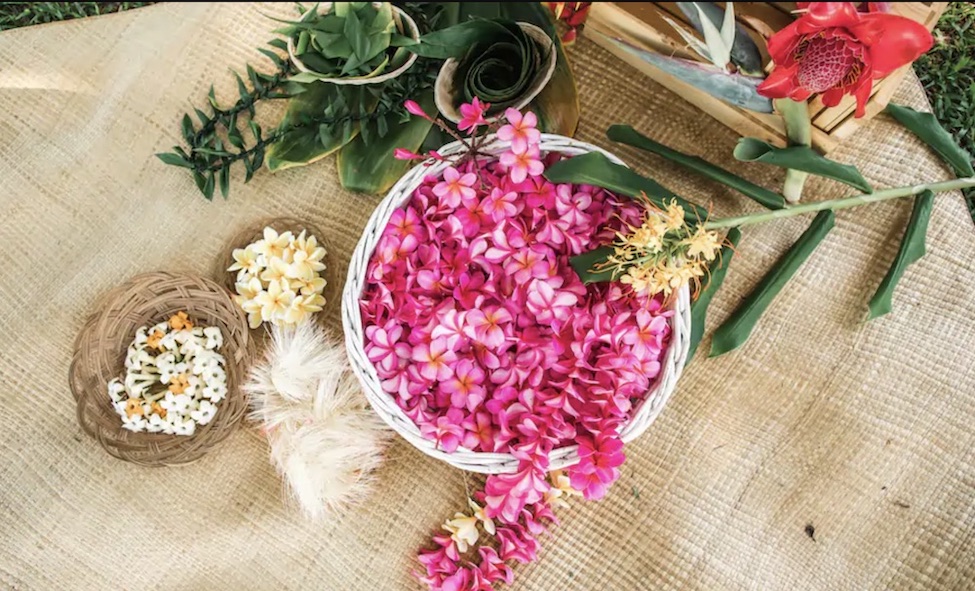
-
Hana-Maui Resort (Best Hotel in Hana)
Hyatt’s Hana-Maui Resort is one of the best places to stay in Hana.
With its minimalist, unpretentious design and prime location along the Road to Hana, this pet-friendly resort is the main (and most beautiful) hotel offering in Hana. We love the ocean-front, grass-enveloped pool.
Most visitors to Maui drive out to Hana for the day, but this is a good option if you wanted to stay locally overnight and would rather stay in a hotel than a small inn (though that can be charming, as well). As we’ll detail below, Hana is a remote, magical part of the island that locals consider to be the “last True Hawai’i”, as it is relatively undeveloped.
Ultimately, with its lovely on-site Farm-to-Table restaurant, charming infinity pool bar, and proximate to the grey sands and gentle waves of Kapueokai Bay (aka Hāna Beach Park), the Hana-Maui Resort is a great place to get away from it all.
If you’re seeking quiet seclusion and privacy on the island, this is the Maui hotel for you.
The Best Things to Do on Maui
Don’t leave the island without having at least some of these iconic local experiences.
***
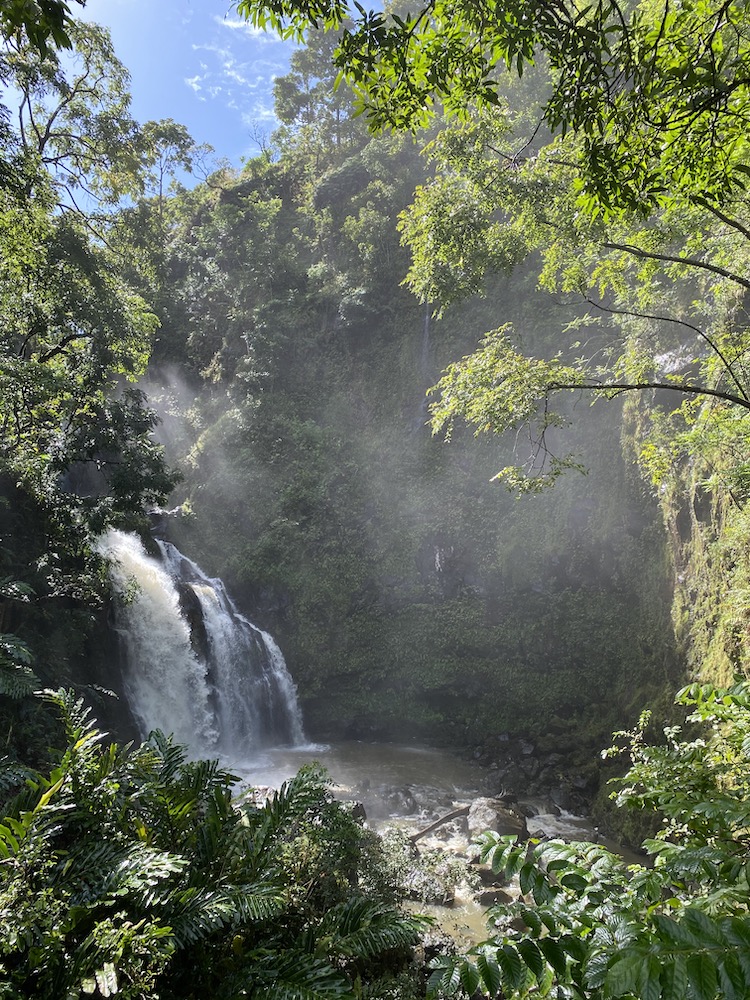
Drive The Road To Hana
It takes a whole day to experience, but driving the Road to Hana is one of the single best things to do on Maui. It’s a quintessential Maui experience unlike anything else on any of the other Hawaiian islands, and I personally don’t think anyone should leave Maui without doing it.
Hana, moreover, is a rural, minimally-developed stretch of pristine jungle that encircles Maui’s North-West shore. It’s known for its gorgeous natural attractions like verdant waterfalls, lush bamboo forests, secluded black sand beaches, wild horses, side-of-the-road fruit stands, and natural attractions like the Hana Lava Tubes and rainbow Eucalyptus groves.
The entire drive is ~64 miles long. The idea is to spend a day driving and periodically pulling over to experience all the roadside attractions. Snap a selfie under a beautiful waterfall, buy some local tropical fruit, take in the serene clifftop ocean, or dip your toes into the waters of a seemingly private beach.
^ You get the idea.
For anyone driving the Road to Hana for the first time, I strongly recommend using the Gypsy Guide to Road to Hana app or the Gypsy Guide Maui app. (<— This is the more comprehensive version that you can use all over the island, not just in Hana.)
^ This GPS-based guided audio tour is perfect for driving around the island. The narrator is a local who gives wonderful insider tips and insights into the local history and culture of each landmark as you pass it. It’s sort of like taking an audio tour of a museum, only it’s designed for real-life destinations.
It’s also helpful to use the Gypsy Guide on the Road to Hana in case you lose cell reception. (The app will continue to work, and can guide you on where to go so that you stay safe and don’t miss anything.)
Other than that, be sure to stop at any of the many roadside cafes to sample some local banana bread. Banana Bread was invented in Hana, and many local cafes and rustic bakeries here claim to be serving the best of the best.
I also recommend sampling some of Coconut Glen’s organic coconut milk ice cream, from the vegan ice cream truck parked near mile marker 27.5 in the jungle of Hana. It was once voted “one of the best ice cream stands on the planet.”
^ I feel pretty confident agreeing with this assessment, if for nothing more than the fact that the ingredients, circumstances, and ambiance here are so charming. Like Hana itself, the experience is one-of-a-kind.
Read our guide to 15 Can’t Miss Experiences on the Road to Hana, here.
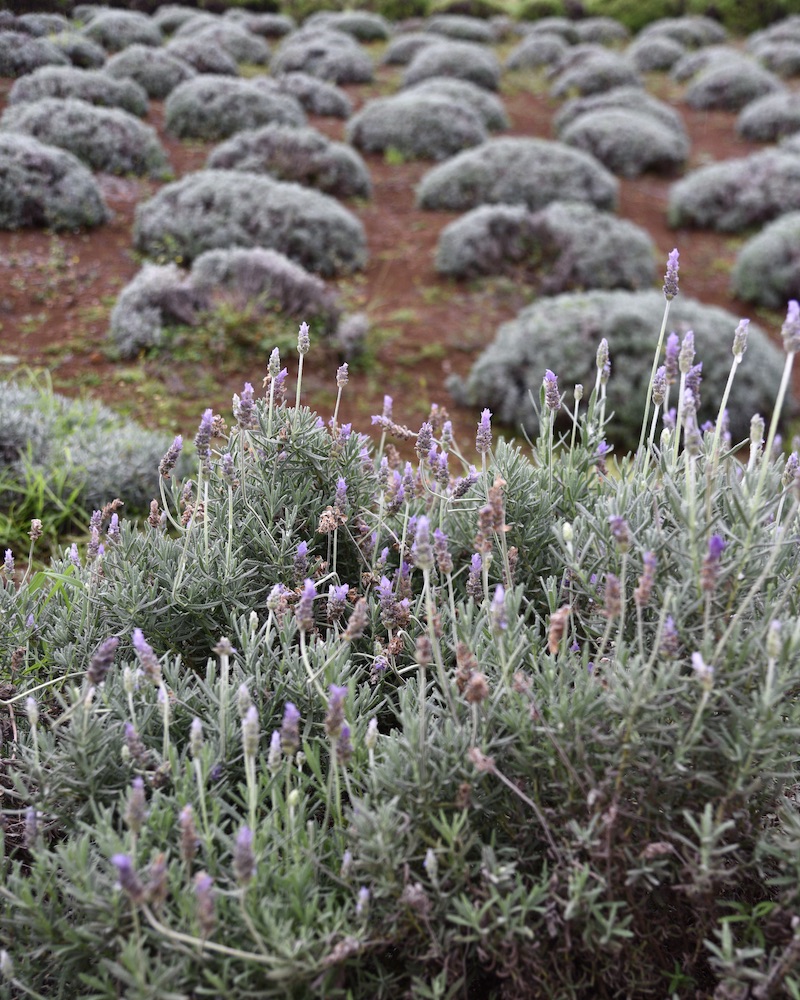
Visit Ali’i Kula Lavender Farm
One of upcountry’s best-kept secrets, this stunning 13.5-acre lavender farm in Kula grows 45 varieties of lavender at 4,000-foot elevation on the slopes of Haleakala Crater.
Ali’i Kula Lavender Farm is open from 9 to 4 PM, and they offer 5 walking tours daily. These take place at 9:30 AM, 10:30 AM, 11:30 AM, 1 PM and 2:30 PM. Each tour typically lasts 30-40 minutes. The price is $12 per person or $10 with Advanced Reservations, which we recommend. Wear comfortable walking shoes and a light jacket, as the slopes of the crater can get chilly on a foggy day.
The farm is also famous for its lavender tea and delicious lavender scones. (<— They’re so good!) These are best enjoyed on the crisp open-air deck overlooking the magnificent property.
Afterward, shop for lavender-infused culinary, bath, and body products. Their gallery and gift shop features over 75 unique lavender-inspired gifts. Picture it: lavender chapstick, lavender chocolate, lavender kombucha, lavender soap and dryer sheets, etc. (We really love the lavender lip balm and the pre-packaged lavender brownies.)
Ali’i Kula Lavender also has seasonal workshops and an incredible array of exotic botanical plants like protea, succulents, olive trees, a citrus orchard, an apple orchard, a vegetable garden, and a native Hawaiian garden. Benches are strewn throughout the property, often nestled into hidden overlooks like a magical scene out of The Secret Garden.
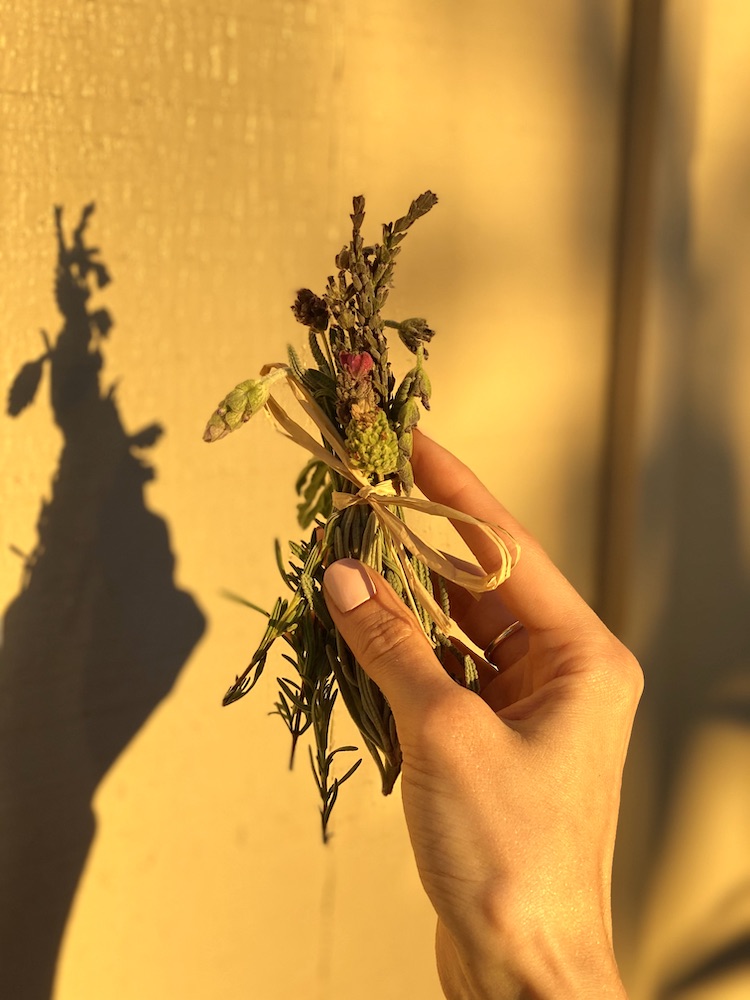
Either way, be sure to stop at the official lavender estate lookout before you leave (you’ll know it when you see the giant Buddha statue); it has some stunning views of the property all the way down to the beaches and further afield volcanos of Maui.
Ali’i Kula Lavender is all about educational stewardship of the land in Kula, which is part of the farm’s mission to purvey “sustainable aloha” to both visitors and locals. Because the mountainside property smells like lavender, it’s very serene.
You can also reserve a lavender gourmet lunch basket, which in addition to salads and sandwiches features lavender chips, a lavender chocolate brownie, and refreshing lavender lemonade.
Either way, be sure to count, smell, touch, and notice the 6 different kinds of lavender that grow on the farm: French Lavender, Provence Lavender, “Kew Red” Spanish Lavender, Sweet Lavender, Super Lavender, and Elegance Lavender.
Your tour guide will talk you through the various lavender crops as you pick and smell each variety one by one. Then, you’ll bundle the flowers into a fragrant bouquet that you can keep. Fortunately, it’s TSA approved, so it won’t get snatched on the flight home! (And it’ll make your luggage smell amazing.)
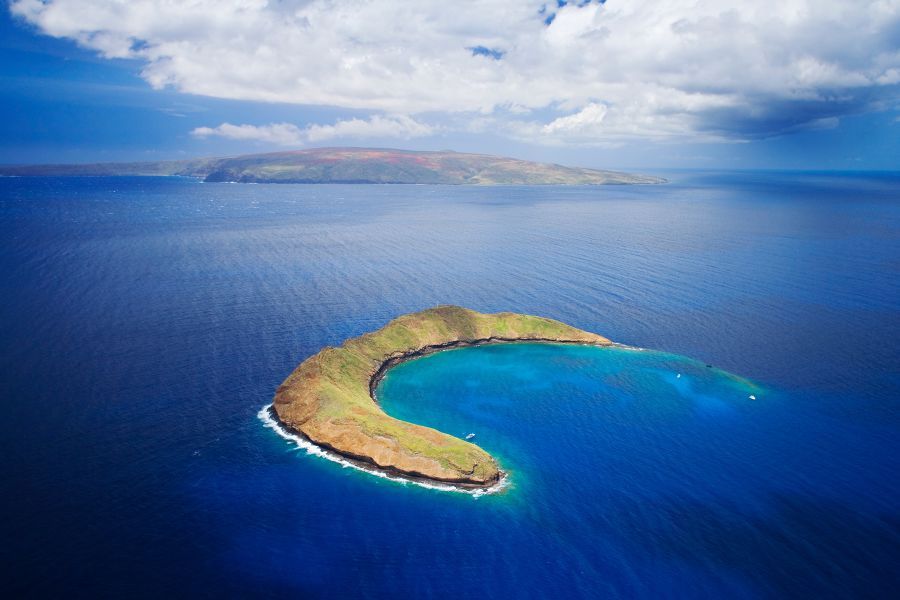
Snorkeling on Molokini Island
Molokini Island is a tiny, crescent-shaped island off the coast of Maui that is one of the world’s great snorkeling hubs.
Accordingly, snorkeling on Molokini Island with a company like Sail Trilogy Tours is a bucket list experience in Maui. They are one of the most popular tour companies on the island, and they fill up quickly during the peak travel season (usually December through early February).
^ Accordingly, be sure to book in advance. Molokini Crater is one of Hawaii’s best snorkel sites!
This charter is known for, among other things, their iconic cinnamon buns– a staple of the lunchtime snorkel offering. Locals and tourists adore them and often rave about this detail as much as the amazing snorkeling.
The company also offers sunset sails from Lahaina, Lanai Coastal snorkels, whale watching in Kaanapali, and more! For more information or to book your sail, go here.
^ FWIW, I recommend Sail Trilogy above other charter companies in the area, but there are a ton of snorkeling tour companies in Maui if they happen to already be booked during your stay, or if you want to shop around and price compare.
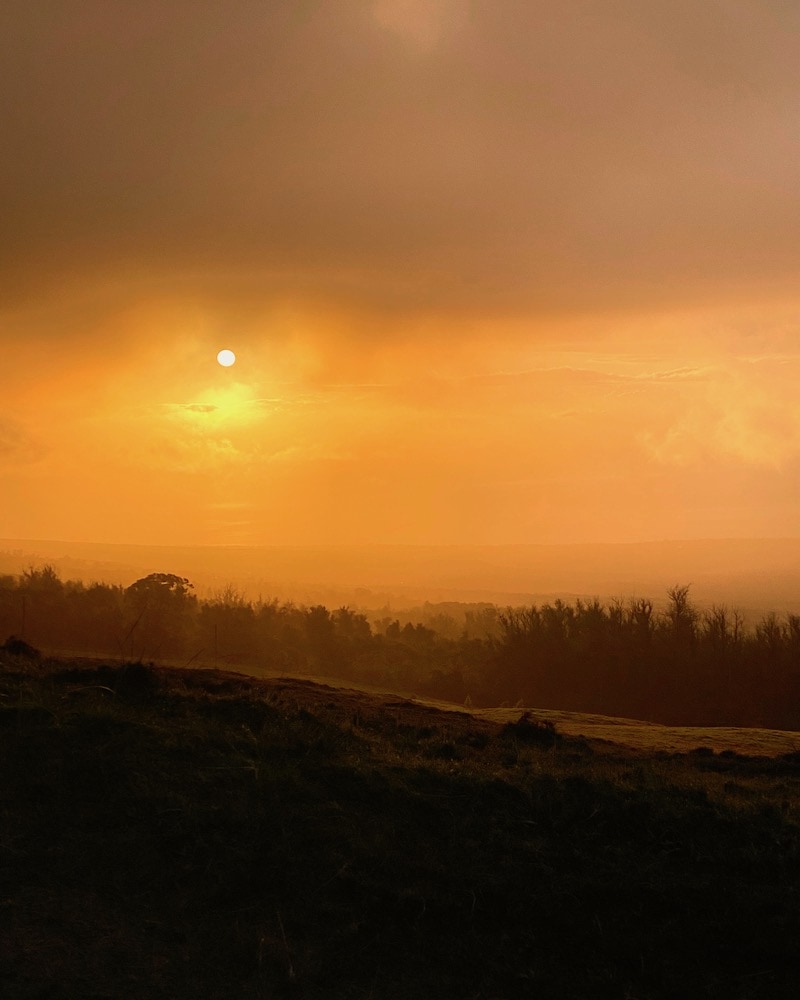
Visit Haleakala for Sunrise or Sunset
Haleakala means “House of the Sun” in Hawaiian, and this vast, majestic landscape looks like outer space! As we wrote in our guide to the Best Sunsets in Maui, Haleakala Volcano is dormant– and the second largest mountain in the world, with a stultifying 10,023 high summit.
Accordingly, it’s a beautiful place to see sunrise or sunset, which is a classic “Maui” experience.
As you climb the summit in your car, eucalyptus forests give way to misty fir forests. Eventually, you’ll pass the cloud layer at 5,000 feet.
Weirdly, it will get dark and murky in the clouds for a bit, and then you’ll emerge into the sunlight on the other side, higher up. It can get cold up here, so bring a jacket or blanket.
If you plan to see a sunrise, you need to book car parking for sunrise in advance! 40 tickets become available 2 days in advance at 7 AM, but no reservations are required for Sunset at this time. Get more info on reservations here.
Sunrise tickets fill up super quickly, so if your heart is set on seeing sunrise at the top of the crater, be sure to book soon after you confirm your flights and accommodation. Sunset atop Haleakala is, however, just as nice in my opinion– and frankly, it’s amazing to go up to the top of the crater any time of day.
Don’t feel bad or like you missed out if you weren’t able to reserve a sunrise spot (no one likes getting up at 4 AM, anyways). Just get to the top whenever you can. The views will never disappoint!
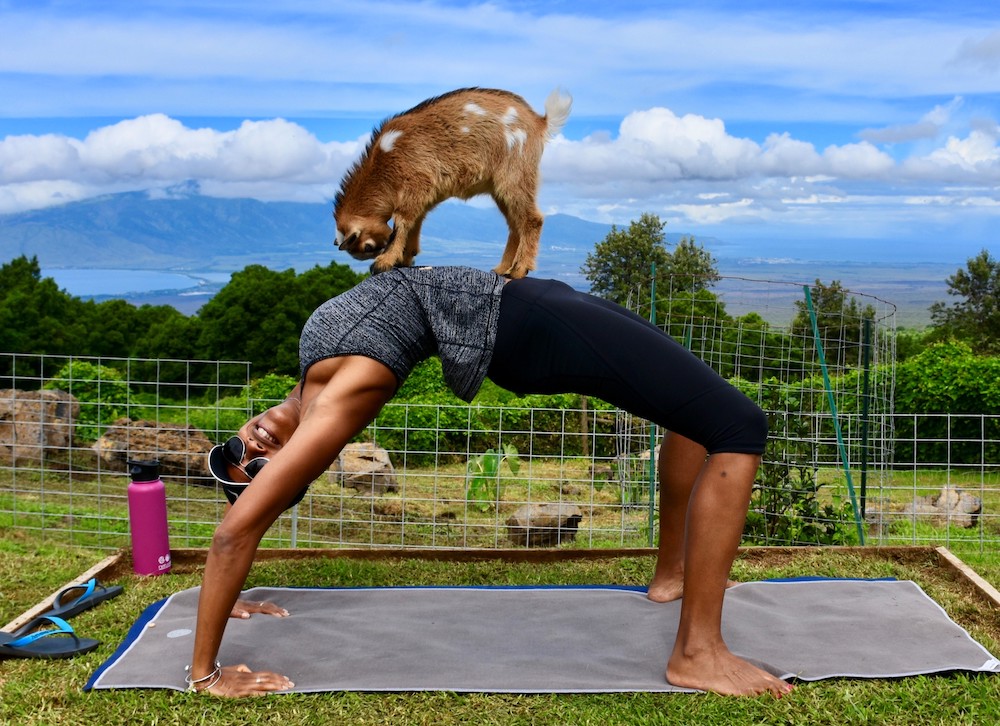
Maui Goat Yoga
I know, weird. Maui Goat Yoga combines animal therapy with yoga, and for the animal lovers among us, it’s just about the cutest experiences Maui has to offer.
Maui Goat Yoga offers a standard morning goat yoga session with baby goats at 9:30 AM daily. They also have a sunset goat yoga class with live music every day.
In my opinion, either is great, especially for animal lovers. (You’ll definitely have lots of laughs and a great photo op with MGY’s miniature goats. You’ll also enjoy beautiful views of the Maui coast!)
All participants must be 12 years or older to take a class. Mats are available to rent on-site, for $5.
To quote the company, Maui Goat Yoga is “much more than just a yoga class– it’s about removing yourself from day-to-day stress and anxiety and focusing on optimistic and happy thoughts and feelings.” Enough said.
Be advised, however, that this yoga class + animal-assisted therapy combo fills up quickly during peak tourism season (e.g. December and January). Be sure to book well in advance!

Learn to Paddle a Traditional Hawaiian Outrigger Canoe
With Hawaiian Outrigger Experience, you can enjoy breathtaking views of the South Maui coast while learning a new skill from warm and knowledgable local guides. Learning to paddle a traditional Hawaiian Outrigger Canoe, moreover, is a quintessential Hawaiian experience that you can only have on the islands.
And as a result of this unique experience, you will also more out of certain references in movies like Disney’s Moana— a great film to watch before visiting Hawai’i. (I highly recommend it!)
All tours and lessons depart from beautiful Wailea Beach. Choose from a variety of adventures like the Cultural and Turtle Tour, where you’ll learn traditional Hawaiian chants (aka “oli”) while getting up close and personal with ancient Hawaiian Green Sea Turtles (aka “honu”– a sacred animal in these parts).
They also have Canoe Snorkel Tours and Canoe Whale Watching Tours. Each presents ample opportunity to take in the sublime coastline of South Maui from the seat of your canoe (aka “hoe wa’a”). With its golden sand beaches, black lava outcroppings, mountain vistas, and views of Molokini Islet as well as Lana’i, this part of Maui is best explored on the water for a reason.
On your tour, you’ll also learn about celestial wayfinding (the art of using stars for navigation, which ancient Polynesian Voyagers excelled at). Drink in the ancestral wisdom, and learn how to share the breath of life (aka “Hā”), which is the root of the word aloha.
Ultimately, this is a super traditional local activity that captures the spirit of ancient Hawai’i. It’s a great activity for history buffs, anthropologists, kayakers, and people who love to sail.
For more information or to book your Maui outrigger experience, go here.
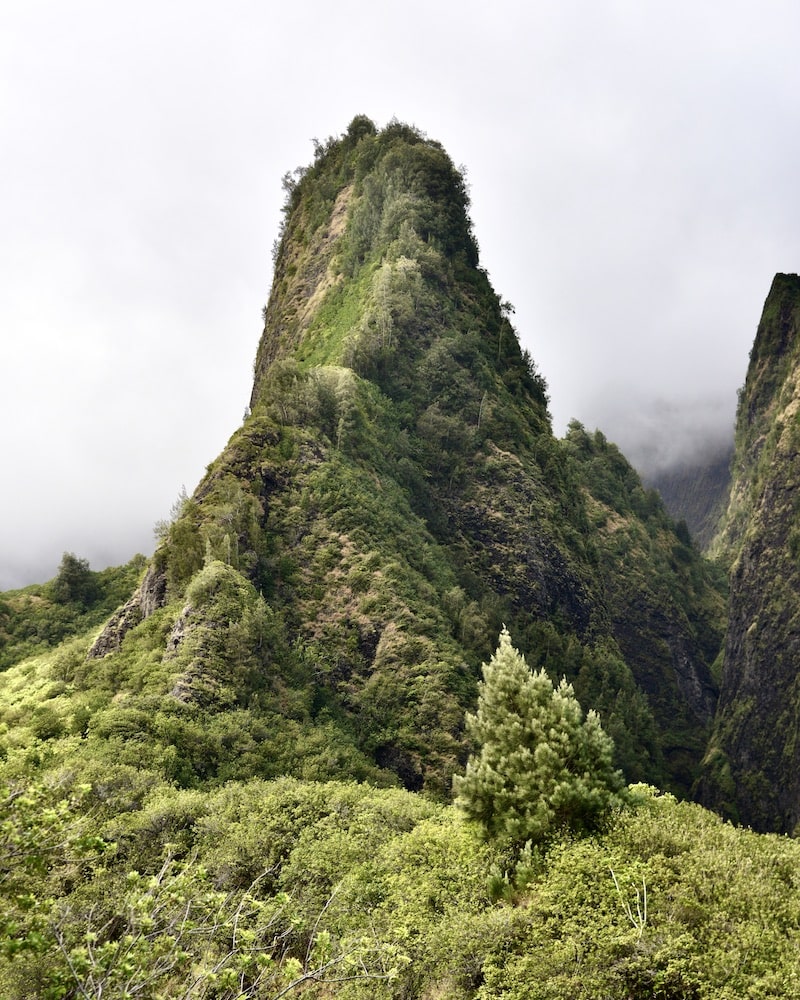
Visit the ‘Iao Needle
The ‘Iao Needle is the iconic landmark in ‘Iao Valley State Park, which is actually the second wettest place on earth. (The wettest place on earth is Mount Waialeale in Waimea Canyon, over in Kaua’i.) So misty is the top of the peak, in fact, that ‘Iao aptly translates to “cloud supreme” in Hawaiian.
With its picturesque rock needle peak (above shown,) the ‘Iao Needle is a favorite photoshoot spot for tourists– and it’s also an important historic site.
It was here at the ‘Iao needle that King Kamehameha I finally defeated the Maui army in his quest to unite all of the Hawaiian islands under one rule. This pivotal battle was a long time coming and marked a critical moment in Hawaiian history.
Today, this easy 0.6-mile walking loop is a great way to see this iconic Maui landmark and to enjoy the ethnobotanical garden surrounding ‘Iao stream. Ideally, go after lunch or before heading on to more time-consuming adventures.
This stop is quick, picturesque, and makes a nice detour from other island explorations, like visiting the nearby sunflower fields in Waikapū.

Explore Lahaina (Gigantic Banyan Tree, Maui Pineapple Store, Glass Blowing Classes, Luaus, & More!)
Lahaina is easily one of the most touristy places on Maui– it’s sort of like the “Waikiki” of the island. Nevertheless, there are a number of iconic things worth checking out in this busy part of town.
The Lahaina Banyan Courtyard, for example, features the oldest living tree on Maui, planted in 1873. It’s hard to believe that this massive, sprawling organism is a single tree!
If you’re looking to shop, Front Street is where all the main boutiques are located. But above all, when exploring Lahaina, definitely be sure to visit the Maui Pineapple Store. Local Maui gold pineapples are super famous and delicious!
Or, consider attending a glassblowing class in the heart of Lahaina at Moana Glass, one of Maui’s most exceptional art destinations. The studio is helmed by Master Glassblower Ryan Staub, who has worked all over the world for two decades and is quite famous within the niche. Glass blowing is a somewhat sacred art in Hawaii, as the volcanic activity of the Hawaiian islands gave humanity some of nature’s first glass.
^ Also, this is a great way to create your own unique Maui souvenir! Get more info on classes and workshops at Moana Glass here.
If you want a chill place to swim, visit Baby Beach– a very relaxed local spot with a tame surf that is popular with local families and those with small children. Doing a sunset sail in Lahaina is also a fun local watersport activity. (More on that and some links to good options, below.) This is because sunsets are best on the West side of Maui, where Lahaina is located.
Enjoying a delicious Ululani’s Shave Ice under the shade of Lahaina’s Banyan Tree is also an indelible Maui experience. (Shave Ice is a classic Hawaiian dessert that you can read more about here.) If you prefer ice cream and want to try some of the best ice cream in Maui, head to Island Cream Co.
Finally, for those who want to experience a traditional luau in Maui, the Royal Lahaina Luau is the most popular option here. It features the classic fire spinners, hula dancers, live music, and an all-you-can-eat-buffet of native Hawaiian food. Be sure to stay for the grand finale, which beautifully captures the spirit and passion of Polynesian culture through indigenous song and dance.

Watch the World’s Greatest Windsurfers at Ho’okipa Beach Park
This massive wave beach on the edge of Pa’ia has some of the best windsurfing conditions on the planet. Professional surfers from all over the world come here to train year-round, and it can be amazing to watch them– especially at sunset.
Several big-time competitions are held here throughout the year, as well. (This is particularly poetic as the word Hoʻokipa literally means “hospitality” in native Hawaiian.)
Those staying nearby should look out for the Jaws Big Wave Championship (Dec-Mar) and the Aloha Classic (late October to early November) to bring some of the world’s best and brightest surfers to Maui.
Other than that, Ho’okipa is a great place to swing by around sunset and watch the surfers hang ten. (The clifftop parking lot overlooks the beach, and is an ideal viewing spot.)
Ultimately, the Ho’okipa overlook makes a great stop en route to or from Pa’ia or Hana. It’s easily something you can tack on en route to another adventure. Unless, that is, you want to surf– in which case, plan to spend an entire afternoon here.
This beach is also an ideal spot to pass time before an early dinner at celebrity-beloved sushi hot spot, Nuka.
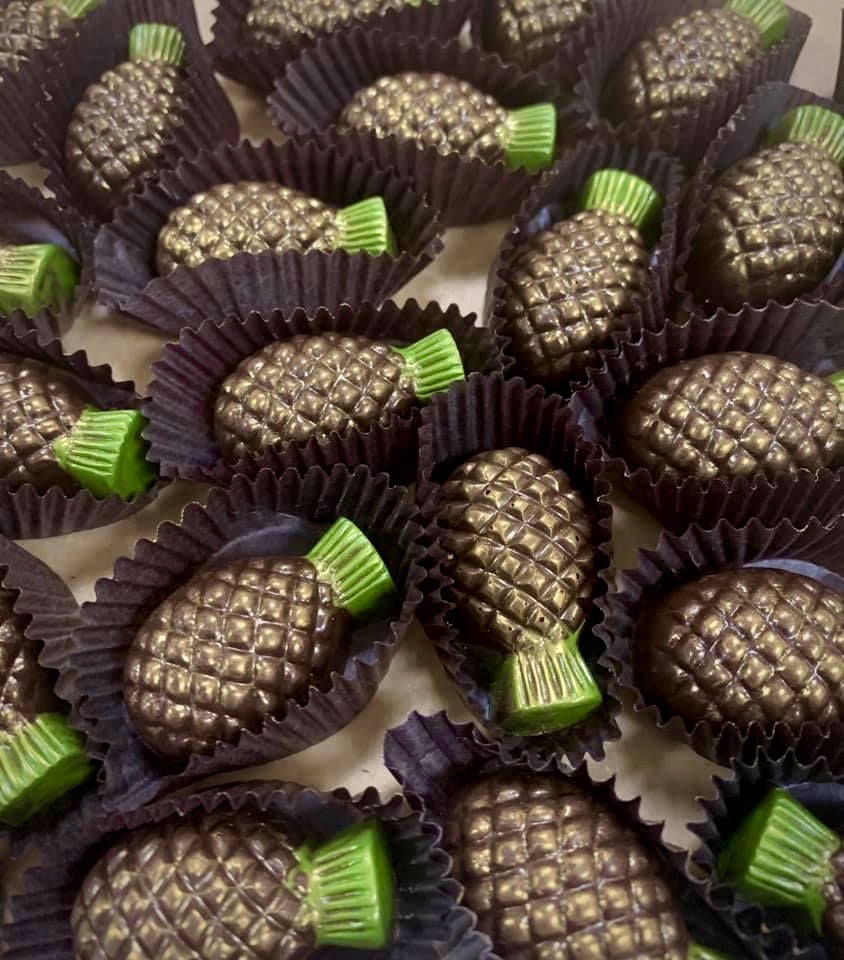
Go to Sweet Paradise Chocolatier For “Hawaiian Chocolate Shots” and HANA GOLD, Maui’s First Branch-to-Bar Chocolate
Sweet Paradise Chocolatier doesn’t really have a robust internet presence, but this boutique chocolate shop is worth a visit for chocolate lovers.
We love their signature “Hawaiian Chocolate Shots”, a $4 shot of 70% Hawaiian-grown Waialua Estate chocolate blended with local vanilla bean, Hawaiian chili pepper, ginger, cinnamon, and almond milk. (Yes, it’s dairy-free.)
The shop also sells local Hana Gold chocolate, Maui’s first entirely branch-to-bar chocolate, which makes a great souvenir. The family-run operation is pesticide- and chemical fertilizer-free. This results in a uniquely sweet and earthy terroir in the resulting chocolate. We love the bars that feature local Moloka’i sea salt!
FWIW, Hana Gold also does plantation tours, for those who want to visit a cacao plantation during their trip to Hana.
(^ Be advised, however, that this may cut time away from other attractions on the Road to Hana. Traffic on Hana’s winding roads is impossible to predict. Budget your time accordingly!)
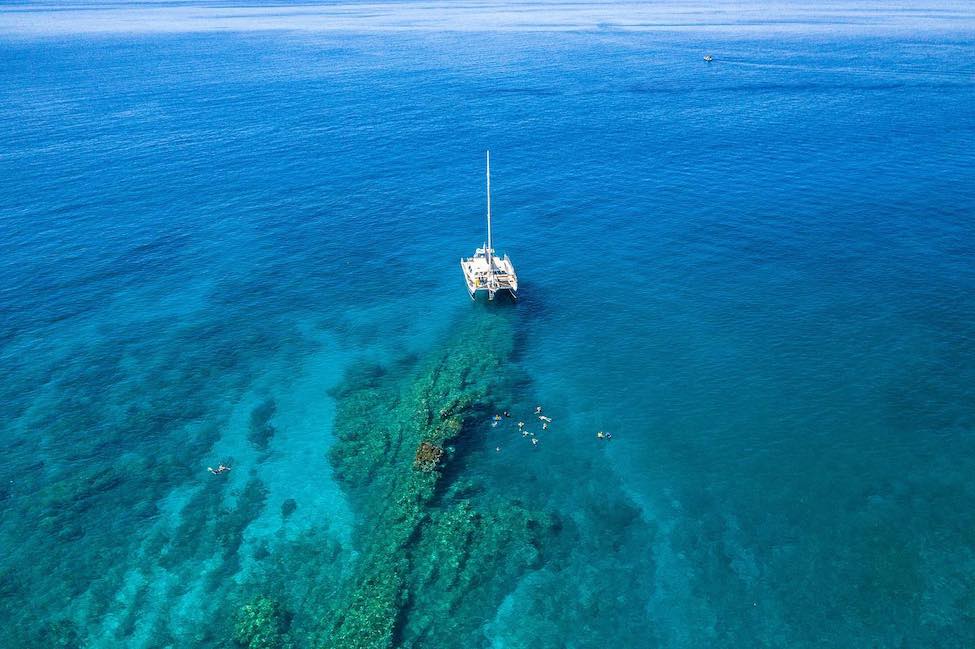
Luxury Catamaran Sailing To Turtle Town with Kai Kanani
South Maui’s only sailing catamaran service departs from Maluaka Beach in Makena. As such, Kai Kanini‘s exclusive launch point gives sailors access to Molokini Crater in just 20 minutes.
They also offer roundtrips to Turtle Town (a famous spot for snorkeling with Hawaiian green sea turtles) which is a bucket list experience. Bring an underwater camera if you can!
The company offers two trips to each location daily. The Sunrise Deluxe Snorkel Tour is a real splurge, but an incredible experience. It begins with you watching the sunrise over Haleakala before they take your party to Molokini Crater to snorkel alone.
Afterward, cruise to Turtle Town and enjoy a snorkel before all the crowds arrive. Privacy, moreover, is the real draw here.
Morning sails offer a full breakfast complete with mimosas and Bloody Marys. Sunset cocktail cruises, whale watching, and private charters are also available.
Overall, sailing on a catamaran is one of the best ways to enjoy the tranquil serenity of Maui’s waters and natural wonders. If you want to experience one of the coolest activities Maui has to offer, this is it!
Get more info here.
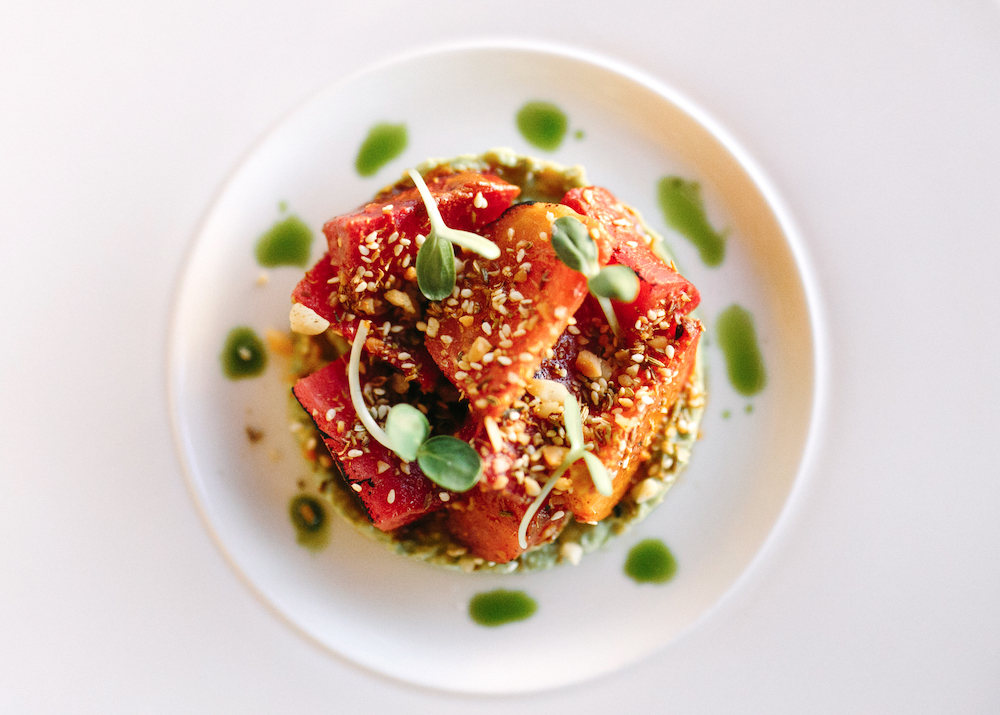
The Best Places To Eat in Maui
Of all the Hawaiian Islands, Maui has some of the best food. (O’ahu and Maui have the best dining options, overall.)
Mama’s Fish House is an iconic waterfront seafood restaurant that is likely the most “Bucket List” restaurant on the island. It’s the #1 place I recommend dining at on Maui. If you could only eat at one restaurant on the island, make sure it’s this one.
Wonderful ambiance and even better hospitality abound at this elegant-but-fun, celebrity-beloved hot spot.
^ Go here for dinner for the quintessential experience. Also, try to order a fish dish made with exotic finger lime. (It’s a rare experience, trust me.) Also, no matter what you do, be sure to save room for dessert. Mama’s does it better than anyone else on the island.
Mill House, meanwhile, is an incredible farm-to-table restaurant on the Maui Tropical Plantation, which celebrates all that is wonderful about Maui’s past and present agricultural magic.
^ From the bespoke sugar cane cocktails (which honor Maui’s biggest historic export,) to the succulent Maui beef dishes, it’s an absolute joy to dine here any time of year. We particularly love the gorgeously-conceived fusion dishes, like Hamachi Kama with ponzu, calamansi lime, green papaya salad, and rice steamed in a banana leaf.
When it’s warm, opt to sit in the lovely open-air Plantation Room, otherwise request a table in the industrial-chic Sugar Room for a cozy dinner. (The restaurant is housed in a former mill– thus the name– and all of the original architectural touches remain intact.)
The Restaurant at Hotel Wailea, on the other hand, was named one of the 100 Best Restaurants in the World according to Conde Nast Traveller, and it is Hawai’i’s first and only upscale Relais & Châteaux restaurant.
(Editor’s Note: You may have seen me mention Relais & Châteaux in my other Travel Well Guides. The Relais & Châteaux distinction belongs only to a select few independently-owned luxury hotels, inns, and restaurants around the globe. It’s a designation of the utmost quality that’s big deal in the hospitality world!)
Go here for a romantic sunset dinner with a view of whales jumping in the distant ocean. Reservations are strongly suggested.
For more detailed restaurant recommendations (including recommendations for breakfast, lunch, dinner, ice cream, and everything in between!) read our guide to The 9 Best Restaurants in Maui.
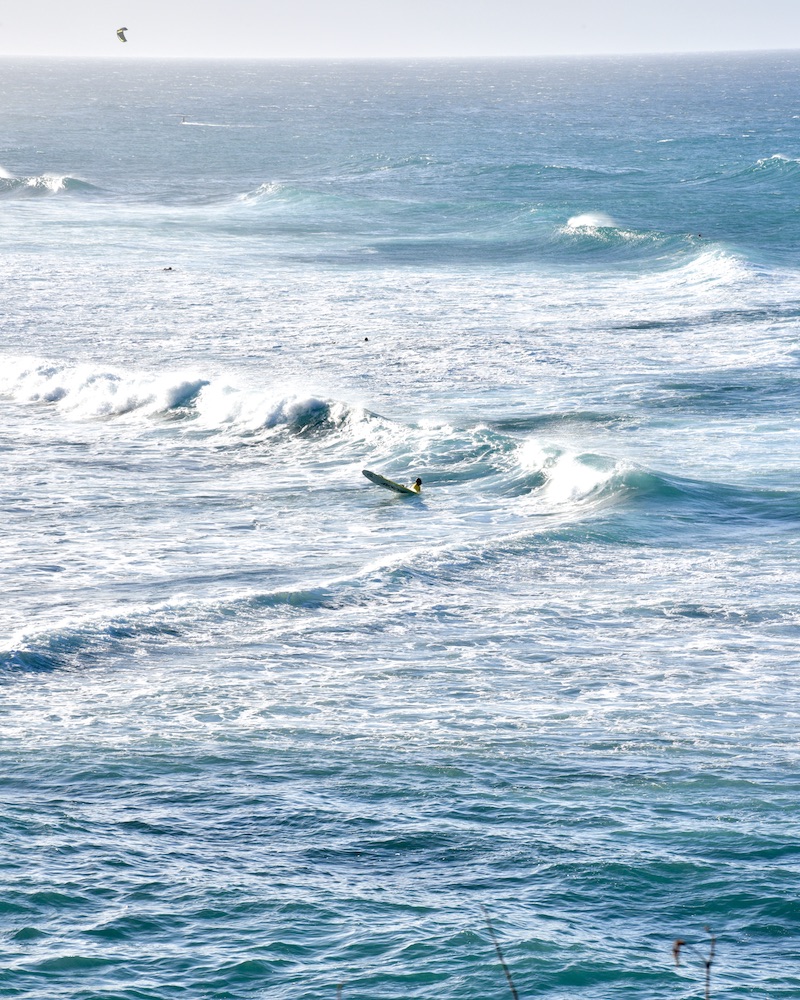
Maui’s Most Famous Beaches
Here’s a basic breakdown of Maui’s best beaches, in a nutshell:
Wailea Beach is upscale and resort-like (in ancient Hawaiian language Wailea meant “Waters of Sacred Happiness”); Baby Beach is chill and popular with locals and families; Ka’anapali Beach is ideal for beach walking, as it is three miles long; Kapalua Bay Beach is great for activities like snorkeling, scuba diving, and boogie boarding; and Baldwin Beach Park is user-friendly for swimmers and has great views of the West Maui Mountains.
Ho’okipa Beach, as detailed above, is where some of the world’s best windsurfers practice. Several pros live on Maui just to use this beach for training! Many professional competitions also take place here each year.
Other than that, most beaches in Maui are lovely in their own right. It all just depends on what activities– like viewing a sunset on the beach— that you are looking to do there.
Either way, sunseekers: just be sure to bring SPF and use a reef-safe sunscreen! The solar rays are quite strong in the Pacific islands, and Maui is no exception.

Cool Ocean Activities for Adventure-Seekers
Kiteboarding on Kanaha Beach, Maui allows you to fly through the air like a true local. The HST Windsurfing and Kitesurfing School offers private, one-on-one lessons here that include all necessary equipment (e.g. kite equipment, helmet, and harness).
As mentioned above, Sail Trilogy offers whale watching in Kaanapali, as well as Maalaea and Lahaina. (The waters of Maui county are the winter stomping grounds of the regional humpback whale population. Pods typically visit the island’s coast from November to April/May.)
Lahaina Divers, meanwhile, offer environmentally responsible SCUBA tours and training at Maui’s best dive sites, including the Lanai Cathedrals, Molokini Crater, and a shipwreck dive for experienced folks that explores a sunken ship, the Carthaginian II, just a short boat ride from Lahaina Harbor. (<— It’s one of the world’s top locations for shipwreck diving!)
Finally, Hawaiian Outrigger Experience— the same company that offers the Hawaiian Outrigger Canoe tours that I detailed above– also offers surf and stand-up paddle lessons, as well as kayak tours. When it comes to watersports in Maui, everything is worth exploring!
-
A Humble Reminder
Again, using a reef-safe sunscreen is critical to protecting Hawai’i’s fragile reef ecosystem, which can be damaged by the chemicals found in most commercial sunscreens. Before entering Maui’s waters, please do your part and shop our guide to the best smart, eco-friendly SPFs, here.
^ These formulas are better for you AND the environment!
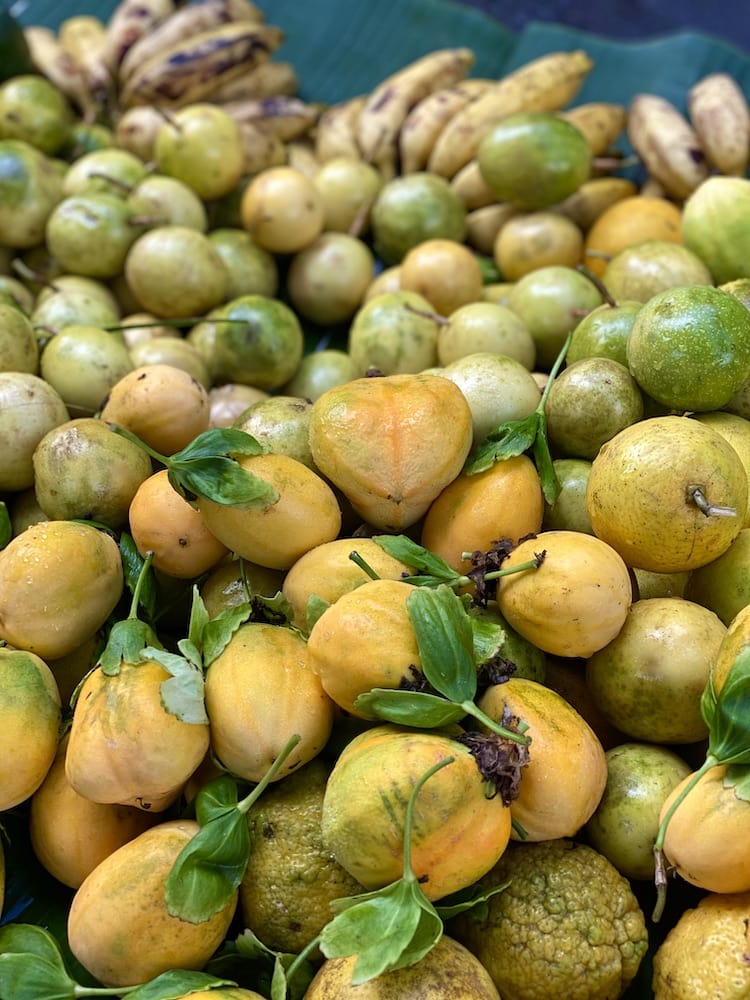
What To Buy in Maui
There are a number of unique food and non-food souvenirs to buy in Maui, and Hawaii writ large.
Quintessential local souvenirs include Maui Fruit Jewels (gourmet tropical fruit jellies that are a hit with locals); Maui Gold Pineapples (available at the airport after security, so you can actually take them home on a plane!); banana bread from Hana; pottery/surfboards/local art from galleries in Ha’iku; Ali’i lavender products from the farm Kula (detailed above); Hana Gold chocolate (also detailed above); and local macadamia nuts. (<— These are a classic, after all! Even the commercial Mauna Loa mac nuts somehow taste better when you buy them in Hawai’i.)
^ These are all great local goods to bring home as souvenirs, as they are classic Maui products. Plus, items like Maui Gold Pineapples and local macadamia nuts will taste much better than anything you could get on the mainland. Trust me.
I would also recommend buying wild passionfruit from a roadside fruit stand in Hana, though you cannot bring it back to the mainland. (Just sample some while you’re on the island– it’s the best passionfruit, ever!)
The Maui Tropical Plantation also sells lovely local coffee. (However, for the best, truly amazing Hawaiian coffee you’ll have to travel to the Big Island of Hawai’i (where Kona coffee originates).
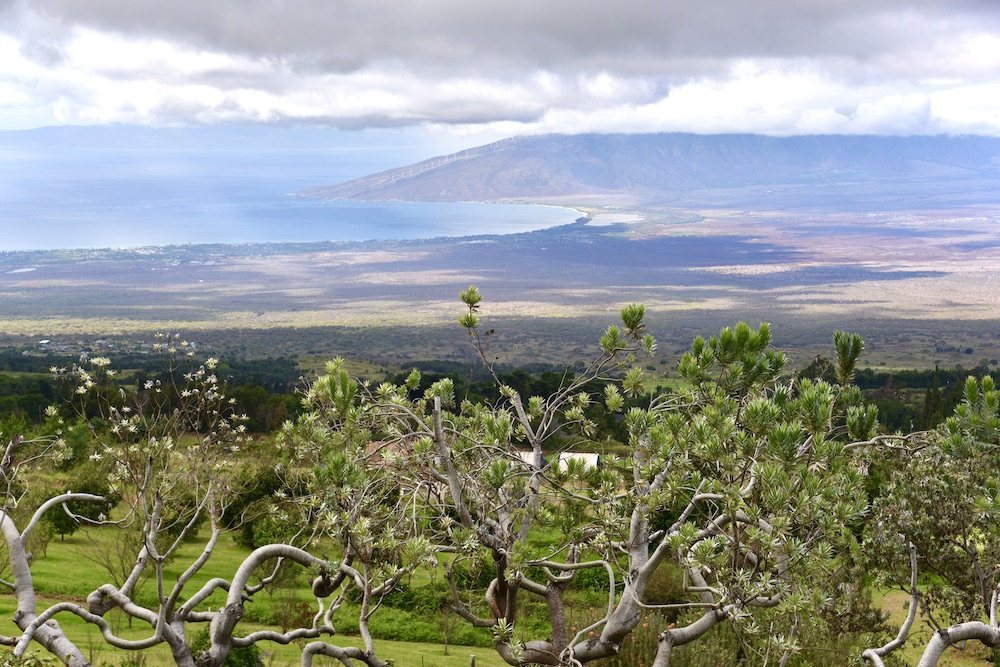
Basic Info About Visiting Maui
Useful info, facts, and figures.
- All international flights to Maui go through Kahului Airport (OGG), which is Maui’s primary airport. The island’s two other airports, Kapalua Airport (JHM) in West Maui and Hana Airport (HNM) in East Maui, cater mostly to small, regional, local, and private flights.
- The local time is HST (Hawaii Standard Time; UTC/GMT – 10 hours) and the currency is the US Dollar.
- Yes, you need to rent a car! You can’t get around the island in a cost-efficient way without one. Check Alamo, Avis, Budget, Enterprise, Hertz, and Dollar Rent-A-Car, which are all available for pick up at Kahului Airport.
- Peak tourism season in Maui runs from December-January each year. This is the busiest and most expensive time to visit the island, but it’s also when the weather is the best (especially if you are coming from somewhere else that’s freezing cold!).
- Maui is a tropical climate, so it experiences warm weather year-round. There is, however, a dry season and a wet season. The dry season in Maui runs from April to October, and the wet season spans from November to March. The annual precipitation average on Maui is about 400 inches, but most of that is in high-elevation rainforests above Hana. Otherwise, if you plan on spending most of your time at the beach or on the coast, you don’t need to pack rain gear. (Kihei, for example, only gets 10 inches of rain annually.)
- Yes, Uber and Lyft are both available on Maui. Both rideshare services can do pickups and dropoffs at Kahului Airport, as well.
- GPS will work reliably all over the island of Maui, except for portions of Hana, where many drivers also occasionally lose cell reception. (See our “Hana” blurb above for more tips on how to avoid getting lost.)
- “Aloha” means hello as well as goodbye, and is used interchangeably in these contexts. However, the real meaning of Aloha in Hawaiian is actually something closer to “peace, happiness, and love.” This is why is it so commonly used as a salutation.
- Finally, plant lovers should keep their eyes peeled for pink damask rose, aka Lokelani rose, which is the official flower of Maui. Once you know what to look for, it can be fun to try and spot it around the island. It’s like a subtle, colorful wink from nature.
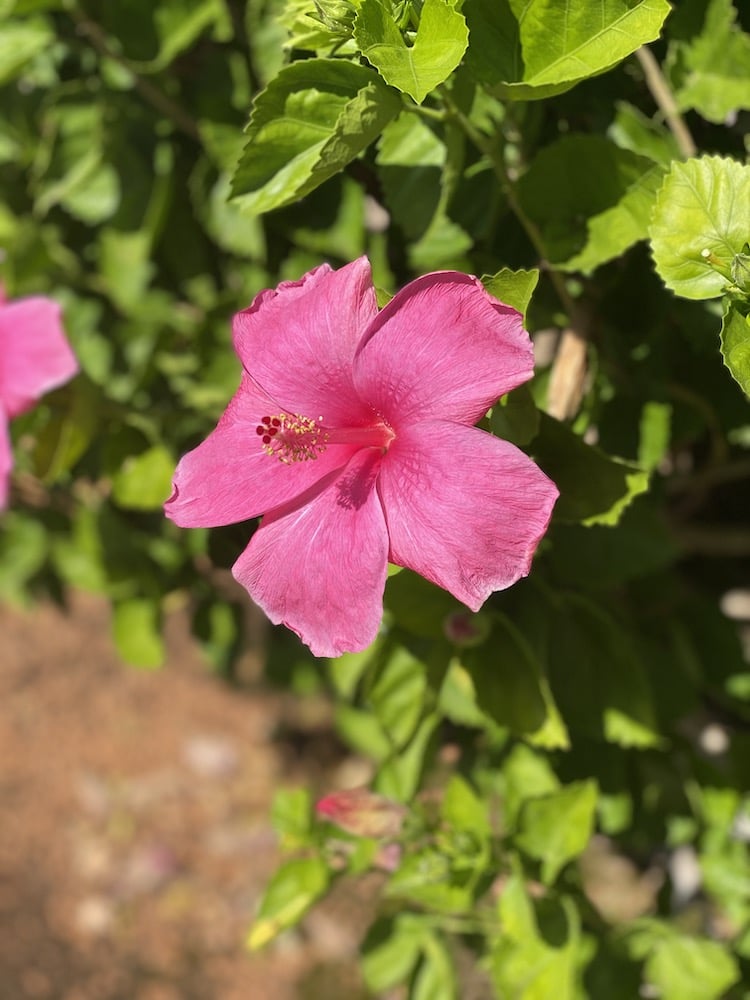
Other Cool, Useful Things to Consider
Just for fun.
- Kumu Farm Stand at the Maui Tropical Plantation in Wailuku is one of the better farm stands in Maui. They sell great local pineapple, sunrise papaya, and coffee as well as over 35 organic crops! Shop here for fresh produce if you’re staying at an Air BnB and want some yummy local fruit for breakfast.
- Mana Foods Maui is a good natural grocery store for those asking.
- Head to Surfing Goat Dairy in Kula for charming dairy farm tours, samples of local goat cheese, and goat cheese truffles.
- For foodies, Alchemy Maui Kombucha Bar + Bistro has great grab-n-go. Be sure to try a sandwich on their Maui artisan sourdough bread! They also have locally-brewed kombucha on tap and in to-go bottles. (I recommend the hemp-infused “Citrus Ohana”, which has notes of rose, lavender, and pine. As far as kombuchas go, it’s super unique!)
- Adventure-seekers might enjoy taking one of Pacific Helicopter Tours private flights over Moloka’i.
- Fragrant Orchids of Maui in Ha’iku is an award-winning, world-class nursery for orchid lovers. People come from all over the world to visit this hideaway in the Ulumanu mountains, though tours are available by appointment only. If you love flowers and orchids, in particular, then be sure to add this to your itinerary.
- Speaking of flowers, Maui Floral Farm in Kula sells the island’s most beautiful collection of hand-sewn leis. If you’re looking for a place to buy authentic leis in Maui, this is a great spot!
- Tasaka Guri-Guri in Kahului’s Maui Mall might not look like much based on its location, but it’s very unique! Guri Guri is a cross between sherbert and ice cream that’s typically made with guava juice, lime soda, and condensed milk. (They call it “Hawaiian Ice Cream”.) Fans of Asian desserts and shave ice, in particular, will love sampling this unique local delicacy, which is only available on Maui. This shop has kept the family recipe a secret for decades!
***
Related: The 9 Best Restaurants in Maui for Unique, Quintessentially “Local” Meals.
Leave a Reply